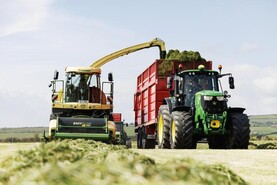I’m glad that May is over and we are now into June. Hopefully this will bring warmer weather.
Despite the cooler conditions I have made a start on making silage. I am pleasantly surprised with how the first of the silage fields has performed.
First to be cut was the red clover grass mix which got a good 24-hour wilt without rain before baling. This averaged at 9.5 bales to the acre. This field received three bags of 0-10-20 earlier this week and I expect to take a second cut in approximately five to six weeks’ time when the clover is mid-bloom.
I took the opportunity of the fine weather last week to save some more silage from some paddocks which had gone strong for grazing. With only small amounts of N fertiliser applied after I had decided to close these up, I had no reservations in mowing down when the opportunity arose. After knocking the grass in ideal conditions, the heavens decided to open overnight. Thankfully, I hadn’t got around to tedding out the grass after mowing and, as I don’t have a conditioner mower, the swards of grass acted like thatch, keeping the grass dry underneath. A few hours’ sun and a good drying wind helped wilt the grass after tedding.
The performance of these fields varied significantly and averaged anywhere from 3.5 to 9.5 bales to the acre. Cutting the silage now will hopefully mean that there will be a good cover of after-grass at the end of the month when I wean the lambs.
All of the ewes have been dagged here on the farm with the exception of one group which is twice the size it should be – a gate left opened in error left two groups mixing together. With so many ewes and lambs together, it isn’t feasible to separate them and they will now have to be run as a much larger group, which is not ideal.
For me, the ideal management group is somewhere in the region of 200 to 250 ewes and their lambs. This allows me enough time to do whatever treatments are required when a group is in the yard, yet it gives me some leeway to do other jobs that also need doing during the day. Thankfully, the cooler weather of late isn’t going to be too conducive for blowfly strike and I hope to get the large group through the yard before the weekend.
A recent faecal egg count carried out on the lambs is showing a high burden in some of the groups. They had received a dose in late April but I have started giving a second worm drench to these groups along with a mineral drench and an application of Click to try to hit this burden.
As the lambs are moving through the race, I am also weighing them and any that are close to slaughter will be marked. This is being made a lot easier as I have installed a new Bluetooth EID wand reader to the weigh scales, which connects directly into the weigh head without any wires for sheep to break. As all weights are recorded beside the tag number and daily liveweight gains shown immediately on the weigh head display, it will help with selecting lambs for slaughter. This device has the capability of recording 1,000 tags a minute but I am yet to test this out. I am not sure if my poor sheep dogs are up to the task of assisting 1,000 sheep through my race in one minute to see if this capability is achievable.






 This is a subscriber-only article
This is a subscriber-only article










SHARING OPTIONS: